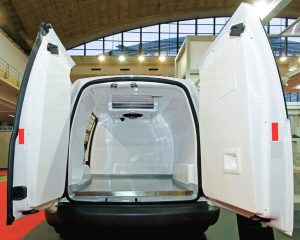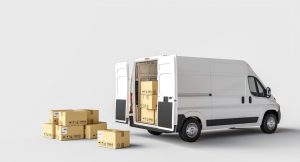When purchasing a refrigerated van, payload and wheelbase are two vital aspects to consider in your selection process. These two factors play a key role in the efficiency and overall performance of your refrigerated vehicle, which can have a big impact your business’ success.
In this blog, we’ll be providing a comprehensive guide to help you understand the key considerations surrounding payload and wheelbase, allowing you to make an informed decision on which refrigerated van is right for you. Whether you’re an experienced business owner or taking the first steps in your start-up business, these factors are vital to think about when it comes to your refrigerated van.
What Payload and Why Does it Matter?
Payload is, and has always been, a major consideration of ours here at CoolKit. This term refers to the total weight that a vehicle can safely carry, excluding the weight of the vehicle itself. For refrigerated vans, payload includes not only the weight of the refrigeration unit and insulation, but also the goods you plan to transport – whether they’re perishable, chilled, or frozen. Our engineers are always focused on improving and innovating to make sure that we’re able to offer the best payload ratios to every brand we work with, no matter their size or industry.
Maximising your van’s payload has significant benefits for your business, such as:
- Reduced Fuel Costs: By transporting more goods per trip, you reduce fuel consumption.
- Lower Maintenance Costs: Less frequent trips means less wear and tear on the vehicle.
- Increased Operational Efficiency: A higher payload allows your business to handle more deliveries, speeding up the process and improving customer satisfaction.
At CoolKit, we offer payload capacities in a number of different sizes, ensuring there’s a solution for every business. Whether you’re in need of a small van for light deliveries or a large van for bulkier shipments, we have a variety of options to meet your needs. Choosing a van with the right payload capacity can mean the difference between needing multiple vehicles, or just one.
Understanding Wheelbase: What it Means and How it Affects Your Van
The wheelbase is exactly what it sounds like; it’s the distance between the front and the rear axles of your van. If you’re using pallets to transport goods then you’ll find it a particularly important consideration, as it determines the amount of space you have available for them. Selecting a van with the correct wheelbase is crucial in ensuring that you have enough available space for transporting goods, to improve efficiency and reduce unnecessary trips.
At CoolKit, we categorise our refrigerated vans into three main wheelbase types to help you determine which one will best suit your requirements:
- SWB (Short Wheel Base)
- MWB (Medium Wheel Base)
- LWB (Long Wheel Base)
Each wheelbase type has its own unique benefits and drawbacks. The type you need will depend on the size of the cargo you’re transporting, and the overall space requirements for your business.
Choosing the Right Wheelbase for Your Needs:
- Short Wheel Base (SWB): Ideal for smaller deliveries. SWB vans are great for manoeuvring in urban environments where space is limited. They’re best suited for businesses specialising in lighter goods.
- Medium Wheel Base (MWB): A balance between space and flexibility. MWB vans are a great versatile option suited to a vast range of businesses. These are the most commonly used wheelbases for businesses transporting medium-sized loads, such as two-pallet deliveries.
- Long Wheel Base (LWB): For businesses that transport larger or bulkier goods, LWB vans provide the most interior space. They are ideal for transporting three or more pallets, and are particularly useful for businesses carrying heavier loads.
Our team here at CoolKit can help you decide which wheelbase is best suited for your specific needs. Whether you need a small van for city deliveries or a larger vehicle for national routes, we have the right option for you.
Selecting the Right Van
To make it easier to choose, we categorise our vehicles into three categories: small, medium, and large. Each category provides specific payload and wheelbase options to meet the diverse needs of our customers.
Small Vans
These vans are ideal for businesses that require a compact vehicle for light deliveries, perfect for getting in tight spaces and congested urban areas.
- 1 pallet vans (1m to 1.5m internal length).
- Payload: 300kg to 500kg (depending on specification).
- Popular Models: Citroen Berlingo, Renault Kangoo, Vauxhall Combo, Mercedes Citan.
Medium vans
Medium-sized vans are perfect for businesses that transport goods that require more space but still need to maintain efficiency in terms of size and manoeuvrability.
- 2 pallet vans (2m to 2.5m internal length)
- Payload: 400kg to 800kg (depending on specification)
- Popular Models: Vauxhall Vivaro, Volkswagen Transporter, Citroen Dispatch, Ford Custom.
Large Vans
Large vans provide the highest payload and are suitable for businesses with heavier or bulkier shipments. They offer ample space for larger deliveries and can handle more substantial loads.
- 3 to 4 pallet vans (2.9m to 4.2m internal length)
- Payload: 800kg to 1300kg (depending on specification)
- Popular Models: Mercedes Sprinter, Renault Master, Ford Transit, Peugeot Boxer
When selecting a refrigerated van, it’s important to consider both payload and wheelbase to get the most out of your vehicle. At CoolKit, we offer a wide selection of fridge vans and freezer vans with impressive payload efficiency that could result in significant cost savings and improved productivity for your business. If you’re unsure which van best fits your needs, don’t hesitate to contact our team for some expert advice.



